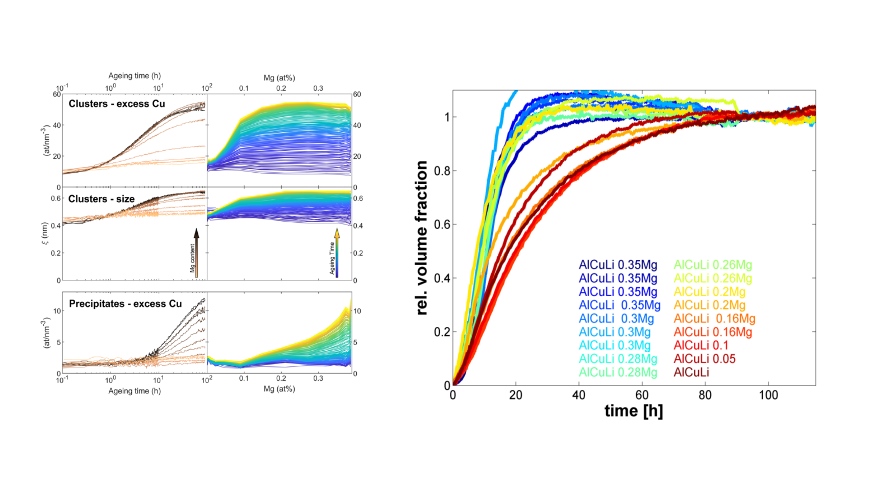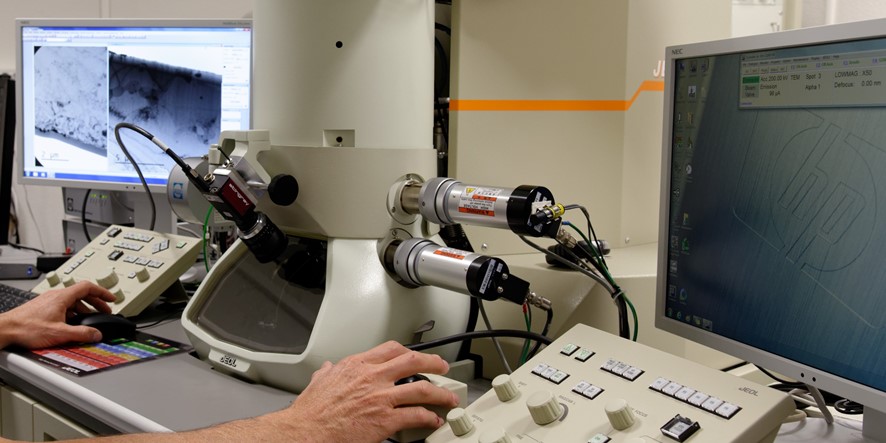The early stages of phase transformations, especially for hardening precipitation in metallic alloys, involve complex interactions between solute elements and supersaturated vacancies resulting from quenching. These interactions influence precipitation trajectories, involving sequences of formation of metastable objects, starting from solute clusters, through metastable phases, to equilibrium phases. Advances have been made in the experimental description of these early stages, where the forming objects (solute clusters) are poorly defined. Statistical approaches to describe compositional fluctuations have proved to be very effective in interpreting the results from atom probe tomography (APT) and small angle X-ray scattering (SAXS) [1,2].
We have been particularly interested in how the addition of minor amounts of solute disrupts these trajectories. If we take as an example aluminium alloys for aerospace applications based on the Al-Cu-Li system, the formation of precipitates depends strongly on the presence of minor elements such as Mg, Ag or Zn. Transmission electron microscopy has shown that the role of these minor elements in catalyzing the formation of the T1-Al2CuLi equilibrium phase is related both to the formation of precursor phases on dislocations, and to the segregation of solutes at interfaces [3,4].
To characterize the effect of composition on the precipitation trajectory, we developed a high throughput, combinatorial-type characterization methodology. Macroscopic compositionally gradient samples are developed and characterized by X-ray scattering resolved in time (in-situ) and space (by scanning the composition gradient). The data obtained show compositional threshold effects (particularly in Mg, figure below) on precipitation trajectories, both on clustering kinetics and on the formation of T1 phase precipitates [5,6]. This combinatorial methodology is being actively pursued in different frameworks, with a thesis in progress on the effects of substitutional solutes on phase transformations in steels [7], and a thesis in progress on precipitation kinetics in aluminium alloys and steels in collaboration with MATEIS and the LMI in Lyon.

[1] L. Couturier, F. De Geuser, A. Deschamps, Direct comparison of Fe-Cr unmixing characterization by atom probe tomography and small angle scattering, Mater. Charact. 121 (2016) 61–67. doi:10.1016/j.matchar.2016.09.028.
[2] R. Ivanov, A. Deschamps, F. De Geuser, A combined characterization of clusters in naturally aged Al-Cu-(Li,Mg) alloys using small-angle neutron and X-ray scattering and atom probe tomography, J. Appl. Crystallogr. 50 (2017) 1725–1734. doi:10.1107/S1600576717014443.[3] E. Gumbmann, W. Lefebvre, F. De Geuser, C. Sigli, A. Deschamps, The effect of minor solute additions on the precipitation path of an AlCuLi alloy, Acta Mater. 115 (2016) 104–114. doi:10.1016/j.actamat.2016.05.050.
[4] E. Gumbmann, F. De Geuser, C. Sigli, A. Deschamps, Influence of Mg, Ag and Zn minor solute additions on the precipitation kinetics and strengthening of an Al-Cu-Li alloy, Acta Mater. 133 (2017) 172–185. doi:10.1016/j.actamat.2017.05.029.
[5] E. Gumbmann, F. De Geuser, A. Deschamps, W. Lefebvre, F. Robaut, C. Sigli, A combinatorial approach for studying the effect of Mg concentration on precipitation in an Al–Cu–Li alloy, Scr. Mater. 110 (2016) 44–47. doi:10.1016/j.scriptamat.2015.07.042.
[6] R. Ivanov, A. Deschamps, F. De Geuser, High throughput evaluation of the effect of Mg concentration on natural ageing of Al-Cu-Li-(Mg) alloys, Scr. Mater. 150 (2018) 156–159. doi:10.1016/j.scriptamat.2018.03.024.
[7] A. Deschamps, F. Tancret, I.-E. Benrabah, F. De Geuser, H.P. Van Landeghem, Combinatorial approaches for the design of metallic alloys, Comptes Rendus Phys. 19 (2018) 737–754. doi:10.1016/j.crhy.2018.08.001.



